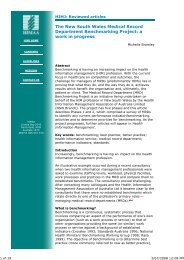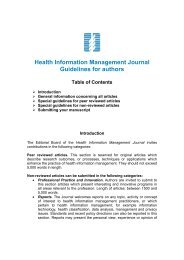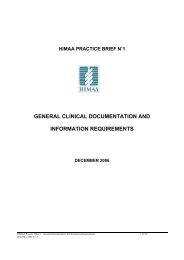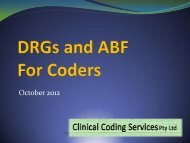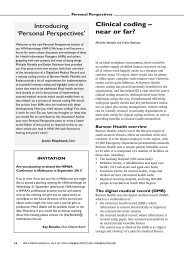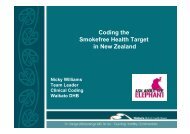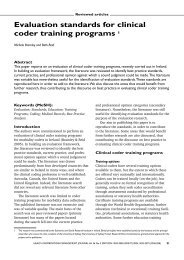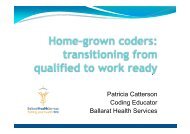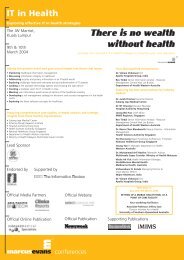A framework for evaluating health classifications - Health Information ...
A framework for evaluating health classifications - Health Information ...
A framework for evaluating health classifications - Health Information ...
You also want an ePaper? Increase the reach of your titles
YUMPU automatically turns print PDFs into web optimized ePapers that Google loves.
Reviewed Articles<br />
4. Usability principles<br />
4.1 Definitions and instructional notes<br />
The categories or subcategories in a <strong>health</strong> classification<br />
must be well defined and supported by definitions<br />
and explanatory notes (Hoffman & Chamie 1999;<br />
Price 1982).<br />
Example 4.1<br />
The Diagnostic and Statistical Manual of Mental Disorders<br />
– Fourth Edition – Text Revision (DSM) (American Psychiatric<br />
Association 2000) is more than a classification, as its<br />
name suggests. The manual is used extensively by mental<br />
<strong>health</strong> clinicians, primarily as a diagnostic tool, but<br />
also as a statistical, research and educational tool, and is<br />
applicable in all <strong>health</strong>care settings. ICD-9-CM is the<br />
statistical classification applied and there are mappings to<br />
ICD-10 codes.<br />
The categories in DSM are differentiated on diagnostic criteria<br />
and other defining attributes of a disorder. They are<br />
extensively defined, and support the practical use of the<br />
manual.<br />
4.2 Indexes/thesauri<br />
Indexes or thesauri are essential to provide users with<br />
easy access to the desired term and its classification.<br />
They should contain all terms relevant to the domain<br />
the <strong>health</strong> classification serves, including synonyms<br />
(Hoffman & Chamie 1999).<br />
Example 4.2<br />
The ICPC-2 PLUS is an electronic interface terminology,<br />
with links to its parent classification, the ICPC-2. To describe<br />
it very simply, it is an electronic index of terms<br />
used in general practice. Terms are managed in a database<br />
which is routinely updated from user feedback.<br />
Each term is given a unique identifier which is then linked<br />
to its relevant category in ICPC-2.<br />
The end product is a clever electronic solution to two<br />
problems: (1) it overcomes the lack of specificity in the<br />
ICPC-2 <strong>for</strong> clinical research purposes; and (2) it simplifies<br />
the work of GPs when classifying or retrieving morbidity<br />
data. A demonstrator model of the ICPC-2 PLUS can be<br />
viewed on the Family Medicine Research Centre’s website:<br />
.<br />
Indexes are also essential tools <strong>for</strong> maintaining <strong>classifications</strong>.<br />
They aid in reducing redundancy and detecting<br />
mis<strong>classifications</strong>.<br />
4.3 Guidelines/training materials<br />
Guidelines or rules on how the classification is to be<br />
used should be available to all users. Training materials<br />
should also be provided, particularly when revisions<br />
or updates are introduced (Hoffman & Chamie<br />
1999).<br />
Example 4.3<br />
Volume 5 of the ICD-10-AM is the Australian Coding<br />
Standards. The aim of the volume is to achieve consistency<br />
in coding through guidelines on the use of the classification.<br />
The standards are written with the assumption<br />
that users have had training in the application of the classification,<br />
are trained in the abstraction of clinical data<br />
from clinical records, and familiar with the ICD conventions<br />
(National Centre <strong>for</strong> Classification in <strong>Health</strong> 2004).<br />
The Australian Institute of <strong>Health</strong> and Welfare has developed<br />
an Australian user guide <strong>for</strong> the International Classification<br />
of Functioning, Disability and <strong>Health</strong> (ICF)<br />
(Australian Institute of <strong>Health</strong> and Welfare 2003). Practical<br />
advice is also included <strong>for</strong> those preparing to implement<br />
the ICF.<br />
4.4 Suitability/acceptability/appropriateness<br />
<strong>Health</strong> <strong>classifications</strong> should be well matched to the<br />
users' work processes and in<strong>for</strong>mation flow to enable<br />
integration (Price 1982). In this sense, <strong>health</strong> <strong>classifications</strong><br />
can be described in terms of their specificity.<br />
The level of detail should match that of the domain it<br />
serves (International Organization <strong>for</strong> Standardization<br />
2000).<br />
Example 4.4a<br />
The ICD-10-AM works well in acute care settings because<br />
of its specificity. However, the five-volume classification<br />
in its manual <strong>for</strong>mat is said to be too detailed <strong>for</strong> use in<br />
general practice (Britt, Beaton & Miller 1995; Parnanen,<br />
Kumpusalo & Takala 2000).<br />
<strong>Health</strong> <strong>classifications</strong> can also be described in<br />
terms of their granularity. The term is often confused<br />
with specificity, generally because granular <strong>classifications</strong><br />
allow more specificity. In in<strong>for</strong>matics, the term<br />
‘granularity’ is defined as ‘the degree of modularity of<br />
a system. More granularity implies more flexibility in<br />
customising a system because there are smaller increments<br />
(granules) from which to choose’ (Answers.com<br />
2005).<br />
Example 4.4b<br />
The Canadian Classification of Interventions (CCI) is more<br />
granular than the Australian Classification of <strong>Health</strong> Interventions<br />
(ACHI) because the CCI has a flexible structure;<br />
it allows codes to be built by taking an element from each<br />
axis (or module or table). The codes in the ACHI are predefined;<br />
elements cannot be added to them <strong>for</strong> greater<br />
specificity.<br />
<strong>Health</strong> <strong>classifications</strong> should not be too complex or<br />
difficult to use, nor should they require more detailed<br />
in<strong>for</strong>mation than is available to the user (Price 1982).<br />
Example 4.4c<br />
The NCCH has worked collaboratively with the AIHW<br />
National Injury Surveillance Unit to include a greater<br />
level of detail in the external causes chapter of the<br />
ICD-10-AM. Guidance <strong>for</strong> some changes has been<br />
drawn from the International Classification of External<br />
Causes of Injury (ICECI). Their rationale is that this<br />
specificity is necessary to make the external cause<br />
codes more useful <strong>for</strong> injury prevention and control<br />
(Harrison 2001).<br />
The effects of this increased specificity on usability<br />
need to be measured. It is uncertain whether this high<br />
level of detail is currently captured in in-patient records<br />
and is able to be coded. Schmertmann & Wil-<br />
<strong>Health</strong> In<strong>for</strong>mation Management 2005 ISSN 1322-4913 Vol 34 No 3 Page 78






